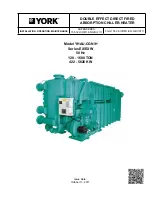
12
8 - CHECKING BEFORE COMMISSIONING
Warning
: the glycol concentration must keep the
fl
uid at least 6°C
below the outlet water temperature foreseen in the evaporator in
order to allow a correct adjustment of the evaporator’s minimum
pressure regulation. If the concentration is below the necessary
amount, there is a risk of freezing. On the other hand, any excess
of concentration entails a decrease in performance.
Minimum usage temperature:
- Mono-propylene glycol
- Mono-ethylene glycol
* Max. 60ºC
+ Good resistance under normal conditions.
0 There may be corrosion problems, especially if other factors
intervene.
- Not advisable.
Note:
For open-circuit installations, if it is not possible to
maintain the water conditions within the values indicated
in the previous table, it will be necessary to install an
exchanger that separates the unit’s circuit from the water
circuit to be treated by using materials compatible with
these characteristics, whether stainless steel or titanium.
Minimum freezing and usage temperature graphs
Freezing temperature:
- Mono-propylene glycol
- Mono-ethylene glycol
Concentration
%
0
10 20 30 40 50
Mono-ethylene glycol (MEG)
ºC
0
-3
-7 -13 -20 -29
Mono-propylene glycol (MPEG) ºC
0
-2
-5 -10 -15 -21
Required glycol concentration
Important: The values are o
ff
ered as a guide according to the
standard characteristics of the MEG. These may vary based on
the MEG manufacturer, which is why it is necessary to consult
the manufacturer data in order to guarantee protection up to the
desired temperature.
Corrosion behaviour
Water content
Concentration (mg/l) AISI 316 Copper
Organic substances
+
0
Electrical
conductivity
< 500
μ
S/cm
+
+
> 500
μ
S/cm
+
-
NH
3
< 2
+
+
2 - 20
+
0
> 20
+
-
Chlorides *
< 300
+
+
> 300
0
+
Sulphites, chloride-free
< 5
0
+
> 5
0/-
0
Iron in solution
< 10
+
+
> 10
+
0
Free carbonic
acid
< 20
+
0
20 - 50
+
-
50
+
-
Manganese in
solution
< 1
+
+
> 1
+
0
pH value
< 6
0
+
6 - 9
0/+
+
> 9
+
0
Oxygen
< 2
+
+
> 2
+
+
Sulphates
< 70
+
+
70 - 300
+
0
> 300
-
-
The units’ hydraulic circuits are made of copper pipes. The
exchanger plates are made of AISI-316 stainless steel, and the
material used for soldering the plates is copper.
The following table indicates corrosion behaviour for copper and
the AISI-316 stainless steel with regard to water with di
ff
erent
compositions. Values outside these ranges can cause corrosion
problems in the hydraulic circuit and in particular in the plate
exchangers.
It is recommended that the water
fi
lling the hydraulic circuits be
fi
ltered and treated, if necessary.
Installation hydraulic diagram
The design of the hydraulic circuit must observe the operating
conditions (
fl
ows - pressure drops).
■
The direction of water circulation must be observed as indicated
on the stickers on the unit.
If more amount is needed, it must be exactly the same mixture
as the product initially used.
The following table and curves feature the minimum glycol
percentages required for the installation in accordance with the
freezing point.
30PA
Ø hydraulic connections
90V-STD to 100V-STD
90V-HEE to 100V-HEE
1 1/4” M
120V-STD to 180V-STD
120V-HEE to 180V-HEE
1 1/2” M
■
The diameters of the unit hydraulic connections can be
consulted in the following table:
-25
-30
-15
-20
-5
-10
0
20
40
50
10
30
-45
-35
-40
0
3
4
1
2
Temperature °C
Volume concentration %
Содержание 30PA 180
Страница 27: ......













































